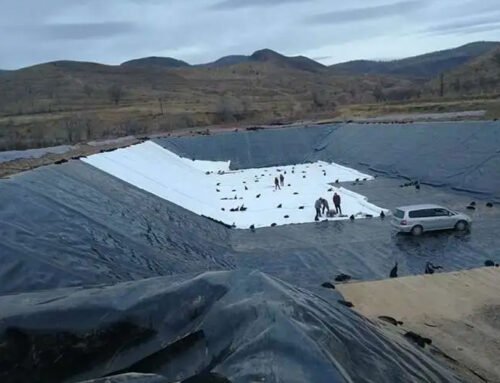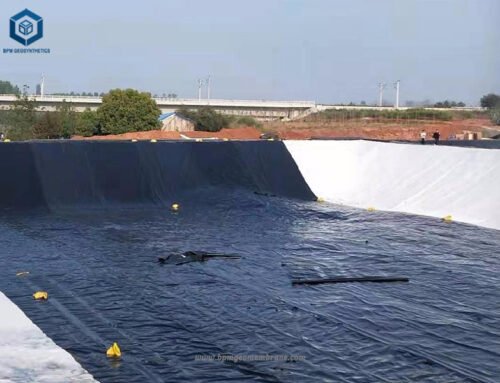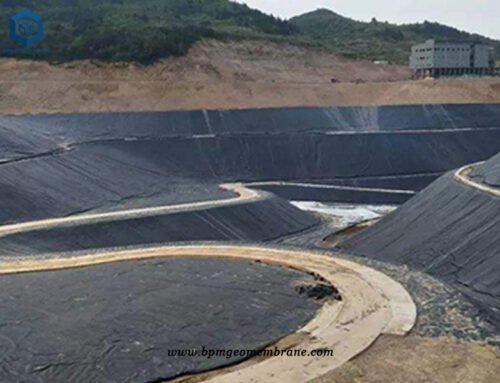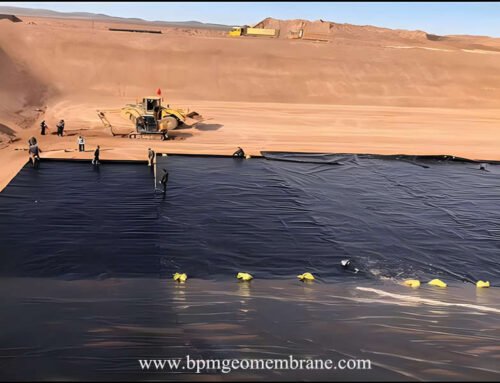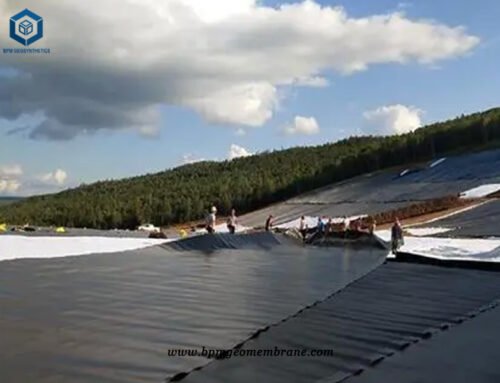High Density polypropylene geomembrane, also known as HDPE geomembrane liner, is the impermeable geotechnical engineering material which is widely used for landfill projects, solid waste containment, mining and water containment applications. BPM is the trusted geomembrane manufacturer and supplier, we offer complete line of smooth geomembrane, textured geomembrane at great price.
1. What Is Polypropylene Geomembrane?
Polypropylene geomembranes are synthetic membranes widely used in geotechnical and environmental engineering projects to control fluid movement. These impermeable sheets or liners are favored for their favorable properties. Polypropylene, a thermoplastic polymer, is commonly used for geomembrane applications.
Polypropylene (PP) geomembranes offer a range of benefits, including exceptional flexibility, elongation, cold temperature resistance, long-term UV stability, and advanced chemical resistance. They are highly flexible and easily fabricated, making tasks like attaching to structures or creating corners simple. PP geomembranes can be installed and welded even in extremely cold conditions, with records of installation at temperatures as low as -50°C (-58°F). Additionally, upon request, we offer an NSF/ANSI Standard 61 certified PP geomembrane, ensuring compliance with drinking water safety standards.
BPM polypropylene geomembranes exhibit outstanding resistance to environmental stress cracking, even in aggressive chemical environments and at elevated temperatures. The PP Series is available in thicknesses of 30 and 40 mil, with panel sizes reaching up to 33,000 square feet.
Polypropylene geomembrane liners excel in various applications, including lining lagoons, ponds, impoundments, and floating covers. They provide superior performance and user-friendly characteristics. The high-performance polypropylene material ensures optimal lining capabilities, meeting the demands of modern projects.
Polypropylene geomembranes offer flexibility, elongation, cold temperature resistance, long-term UV stability, and advanced chemical resistance. They are easy to fabricate and install, even in extreme cold conditions. BPM’s polypropylene geomembranes provide exceptional resistance to environmental stress cracking and are available in various thicknesses and panel sizes. These geomembrane liners are ideal for lining lagoons, ponds, and other containment systems, providing superior performance and user-friendliness.
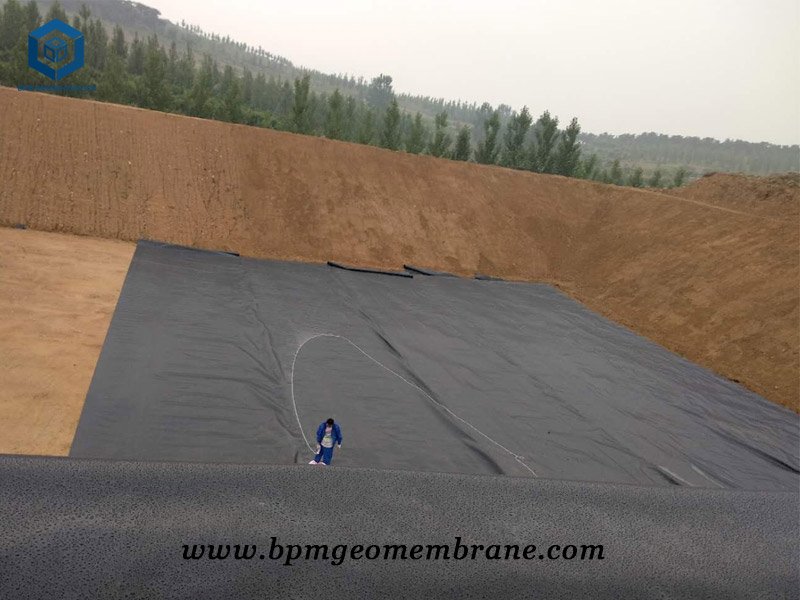


2. What Is The Raw Material for Geomembrane?
The raw material for the production of geomembranes, specifically polyethylene geomembranes, is virgin polyethylene resins. These resins are derived from petroleum or natural gas through the process of polymerization. Virgin polyethylene resins have specific properties that make them suitable for geomembrane applications, such as their durability, flexibility, and impermeability.
In addition to polyethylene resins, carbon black is commonly added as a filler material during the manufacturing process. Carbon black is a form of elemental carbon that is finely divided and used to enhance the geomembrane’s properties. It helps improve the geomembrane’s resistance to ultraviolet (UV) radiation, which can cause degradation over time.
By combining virgin polyethylene resins with carbon black, manufacturers can produce high-quality polyethylene geomembranes that offer excellent performance and longevity in various geotechnical and environmental engineering applications.
3. What Is the Difference Between PVC And HDPE Geomembrane?
The main difference between PVS geomembrane and HDPE lies in their material composition and physical properties. PVC geomembranes are flexible and relatively easy to handle, while HDPE Geomembranes is tough and non-flexible.
3.1 Material Composition
Geomembrane is a broad term that refers to a category of synthetic liners used in geotechnical and environmental applications. It encompasses various materials such as PVC, HDPE (High-Density Polyethylene), and other types of polymers. HDPE, on the other hand, specifically refers to a type of geomembrane made from high-density polyethylene resin.
3.2 Flexibility
Geomembranes are known for their flexibility and relative ease of handling. They can conform to irregular surfaces and are often used in applications where flexibility is required, such as lining ponds or creating flexible barriers. HDPE geomembranes, on the other hand, are tough and non-flexible. They are typically used in applications where strength and puncture resistance are important, such as landfill liners or containment systems.
3.3 Physical Properties
PVC geomembranes offer advantages such as high flexibility, elongation, and ease of fabrication. They are also resistant to UV radiation and have good chemical resistance. HDPE geomembranes, on the other hand, are known for their toughness, high tensile strength, and resistance to puncture and tearing. They have excellent resistance to chemicals, UV radiation, and environmental stress cracking.
3.4 Applications
Due to their flexibility, PVC geomembranes are commonly used in applications such as pond and lagoon liners, decorative water features, and flexible containment systems. HDPE geomembranes, with their superior strength and durability, are often used in applications such as landfill liners, mining tailings ponds, and industrial containment.
HDPE is a specific type of geomembrane made from high-density polyethylene, geomembrane is a broader term that encompasses various materials, including PVC, HDPE, and others. The choice between PVC and HDPE geomembranes depends on the specific requirements and conditions of the application.
4. Why Chose High Density Polypropylene Geomembrane for Landfill Project in Ghana
A customer from Ghana discovered our company’s email address through a Google search and reached out with specific requirements for a high-density polypropylene (HDPE) geomembrane for a landfill project. The customer specified a thickness of 1.5mm and a need for the geomembrane to exhibit impermeability, water resistance, and rupture strength of at least 40KN/M. They requested quotations to be sent by 10 p.m.
In response to the customer’s requirements, our dedicated business personnel promptly prepared product and production videos, along with all the necessary test reports, to provide comprehensive information for the customer’s review and confirmation.
To allow the customer to physically assess the HDPE geomembrane, we promptly mailed free geomembrane liner samples the following day. The HDPE geomembrane sample met all the project requirements, satisfying the customer’s expectations. Additionally, we made every effort to provide a competitive price that suited the customer’s budget.
The customer’s satisfaction with the product, pricing, and service was evident as, within a week of initial contact, we successfully signed the contract. This signifies a strong partnership between our company and the customer for their landfill project in Ghana.
Our company’s responsiveness, provision of detailed information, prompt sample delivery, competitive pricing, and successful contract signing demonstrate our commitment to meeting and exceeding the customer’s needs and expectations.
5. Specifications of Polypropylene Geomembrane for Landfill in Ghana
- Total quantity – 56,000m2
- Textured Geomembrane thickness – 1.5mm
- Each roll size – 7m*100m
6. About BPM
BPM is the professional geosynthetics manufacturer and exporter. Our main innovative, high quality geosynthetic products include geomembranes, geotextiles, geocells, geosynthetic clay liners (GCLs), drainage boards, geogrids, etc. BPM brand geosynthetic product had been certificated by the ISO9001, ISO14001,OHSAS18001 Soncap, SASO and BV certificates and passed the test of SGS and Intertek, etc. Our geosynthetic products have exported to over 36 countries.
BPM Geomembrane is also providing professional geomembrane design and installation service. OEM and ODM are also available. If you have any questions or inquiries, please contact us, we will reply as soon as possible.

